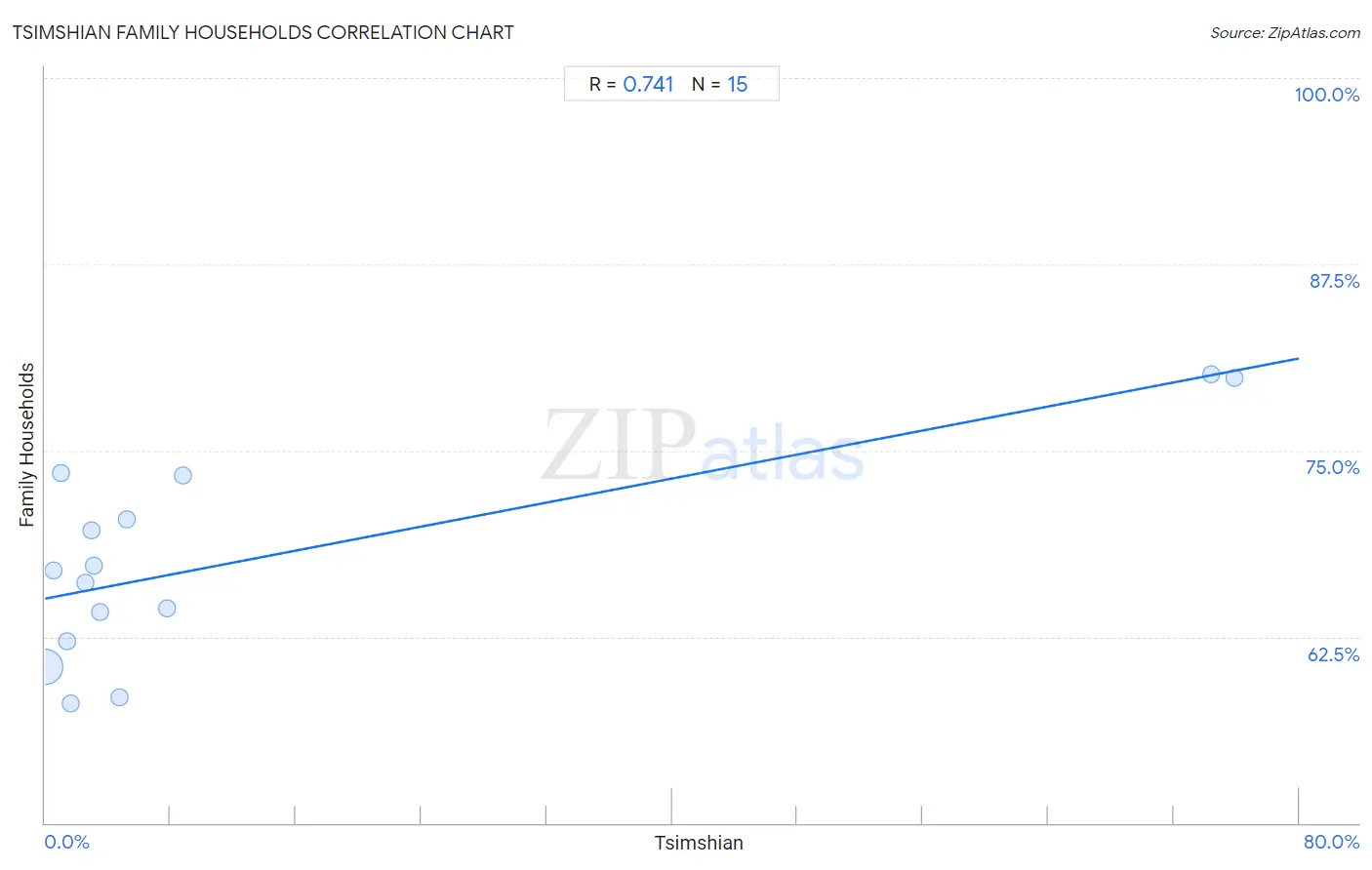Tsimshian Family Households
COMPARE
Tsimshian
Select to Compare
Family Households
Tsimshian Family Households
67.1%
FAMILY HOUSEHOLDS
100.0/ 100
METRIC RATING
37th/ 347
METRIC RANK
Tsimshian Family Households Correlation Chart
The statistical analysis conducted on geographies consisting of 15,626,544 people shows a strong positive correlation between the proportion of Tsimshian and percentage of family households in the United States with a correlation coefficient (R) of 0.741 and weighted average of 67.1%. On average, for every 1% (one percent) increase in Tsimshian within a typical geography, there is an increase of 0.20% in percentage of family households.

It is essential to understand that the correlation between the percentage of Tsimshian and percentage of family households does not imply a direct cause-and-effect relationship. It remains uncertain whether the presence of Tsimshian influences an upward or downward trend in the level of percentage of family households within an area, or if Tsimshian simply ended up residing in those areas with higher or lower levels of percentage of family households due to other factors.
Demographics Similar to Tsimshian by Family Households
In terms of family households, the demographic groups most similar to Tsimshian are Peruvian (67.1%, a difference of 0.070%), Tohono O'odham (67.1%, a difference of 0.080%), Mexican American Indian (67.0%, a difference of 0.10%), Immigrants from El Salvador (67.0%, a difference of 0.12%), and Salvadoran (67.2%, a difference of 0.13%).
| Demographics | Rating | Rank | Family Households |
| Immigrants from Peru | 100.0 /100 | #30 | Exceptional 67.2% |
| Immigrants from Latin America | 100.0 /100 | #31 | Exceptional 67.2% |
| Nepalese | 100.0 /100 | #32 | Exceptional 67.2% |
| Salvadorans | 100.0 /100 | #33 | Exceptional 67.2% |
| Thais | 100.0 /100 | #34 | Exceptional 67.2% |
| Tohono O'odham | 100.0 /100 | #35 | Exceptional 67.1% |
| Peruvians | 100.0 /100 | #36 | Exceptional 67.1% |
| Tsimshian | 100.0 /100 | #37 | Exceptional 67.1% |
| Mexican American Indians | 100.0 /100 | #38 | Exceptional 67.0% |
| Immigrants from El Salvador | 100.0 /100 | #39 | Exceptional 67.0% |
| Guamanians/Chamorros | 100.0 /100 | #40 | Exceptional 66.6% |
| Immigrants from Bolivia | 100.0 /100 | #41 | Exceptional 66.6% |
| Menominee | 100.0 /100 | #42 | Exceptional 66.5% |
| Apache | 100.0 /100 | #43 | Exceptional 66.5% |
| Asians | 100.0 /100 | #44 | Exceptional 66.5% |
Tsimshian Family Households Correlation Summary
| Measurement | Tsimshian Data | Family Households Data |
| Minimum | 0.024% | 58.0% |
| Maximum | 75.9% | 80.1% |
| Range | 75.8% | 22.1% |
| Mean | 12.9% | 67.7% |
| Median | 3.1% | 67.0% |
| Interquartile 25% (IQ1) | 1.4% | 62.2% |
| Interquartile 75% (IQ3) | 7.8% | 73.3% |
| Interquartile Range (IQR) | 6.3% | 11.1% |
| Standard Deviation (Sample) | 25.4% | 6.9% |
| Standard Deviation (Population) | 24.5% | 6.7% |
Correlation Details
| Tsimshian Percentile | Sample Size | Family Households |
[ 0.0% - 0.5% ] 0.024% | 15,404,738 | 60.5% |
[ 0.5% - 1.0% ] 0.53% | 171,789 | 67.0% |
[ 0.5% - 1.0% ] 0.99% | 15,580 | 73.5% |
[ 1.0% - 1.5% ] 1.41% | 3,691 | 62.2% |
[ 1.5% - 2.0% ] 1.62% | 804 | 58.0% |
[ 2.5% - 3.0% ] 2.53% | 1,736 | 66.1% |
[ 2.5% - 3.0% ] 2.92% | 822 | 69.6% |
[ 3.0% - 3.5% ] 3.10% | 838 | 67.3% |
[ 3.0% - 3.5% ] 3.46% | 13,913 | 64.2% |
[ 4.5% - 5.0% ] 4.77% | 8,168 | 58.4% |
[ 5.0% - 5.5% ] 5.18% | 656 | 70.4% |
[ 7.5% - 8.0% ] 7.76% | 361 | 64.4% |
[ 8.5% - 9.0% ] 8.79% | 546 | 73.3% |
[ 74.0% - 74.5% ] 74.40% | 1,465 | 80.1% |
[ 75.5% - 76.0% ] 75.85% | 1,437 | 79.9% |